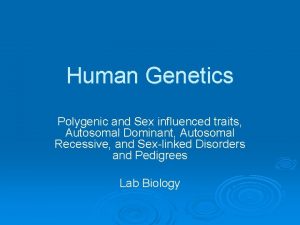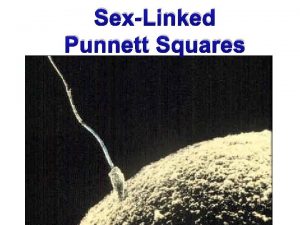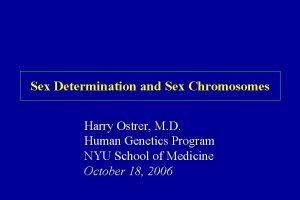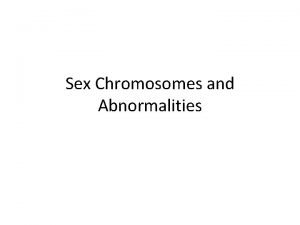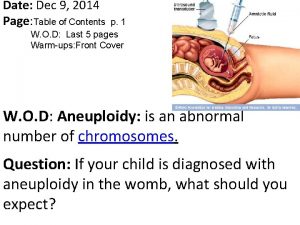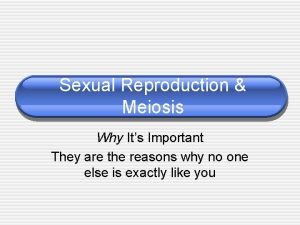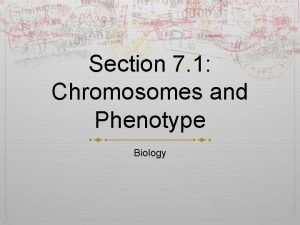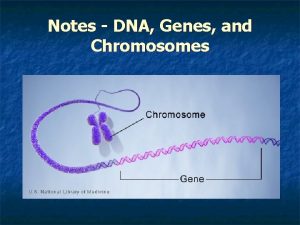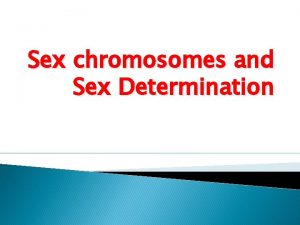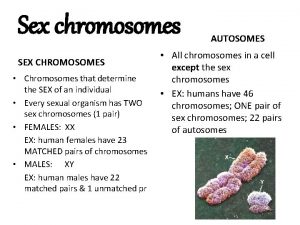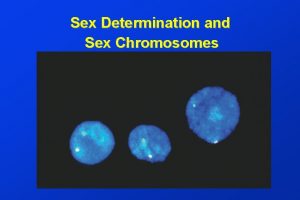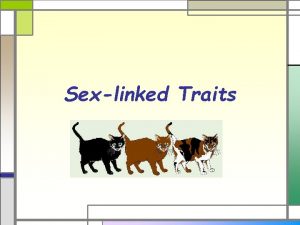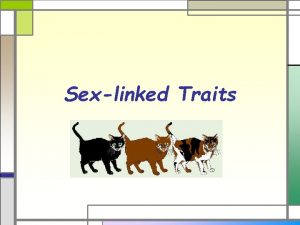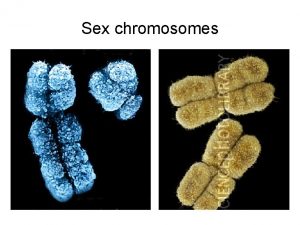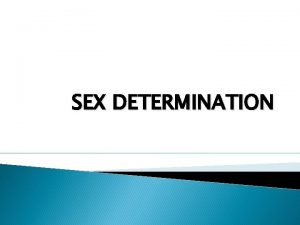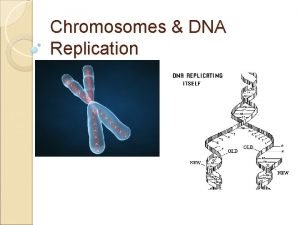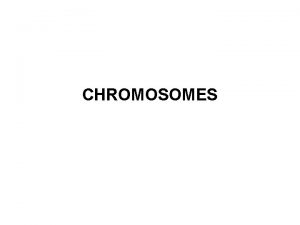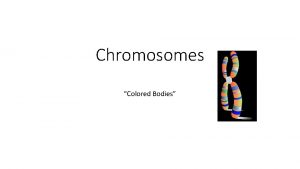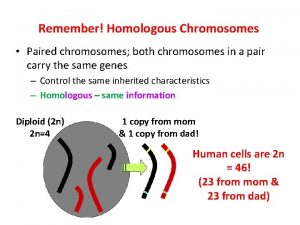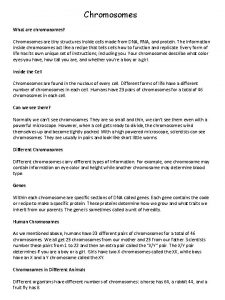Sex Determination and Sex Chromosomes Harry Ostrer M




























- Slides: 28

Sex Determination and Sex Chromosomes Harry Ostrer, M. D. Human Genetics Program NYU School of Medicine October 18, 2006

What causes sex differences? What are sex chromosomes doing?

Development of the Embryonic Gonad Genital ridge Hindgut Metanephric duct Yolk sac Mesonephros Cloaca It starts with germ cell migration at 4 weeks Retinoic acid in germ cell environment influences differentiation Sertoli cell – gonocytes (Mitotic arrest) Elsewhere – oogonia (Entry into meiosis)

Organization of the Seminiferous Tubule and Ovarian Follicle Spermatozoan Round spermatid Sertoli cell Spematocyte Spermatogonia Peritubular myoid cells Vascular endothelial cell Leydig cells 1 o Oocyte Follicular cells

Development of male and female internal genitalia Metanephros Seminal vesicle Wolffian Ducts Vas deferens + testosterone Ureter Mesonephros Gonad + MIF Müllerian Ducts Epididymis Testis + SRY Fallopian tube Mullerian duct Wolffian Ducts Wolffian duct Ovary Mullerian tubercle Urogenital sinus Müllerian Ducts Uterus Upper third of vagina

Development of Male and Female External Genitalia tubercle folds swellings + dihydrotestosterone folds swellings Common Genital Analgen tubercle folds swellings

Expression Of SRY in the Developing Male Embryo 7 wks alk phos 9 wks 10 wks 12 wks antisense

Aberrant Sex Chromosome Transmission Usual observation 46, XY 45, X 47, XYY 46, XX 47, XXY 47, XXX 48, XXYY 48, XXXX 48, XXXY 49, XXXXX 49, XXXXY Exceptions 45, X 46, XY with gonadal dysgenesis 69, XXY triploidy with gonadal dysgenesis

Recombinational Models for Individuals with Genetic Sex Reversal SRY Y X Non-homologous Recombination SRY Y Y X 46, XX male 46, XY female X Unequal Recombination

Genes Involved in Male Sex Determination alpha-thalassemia retardation syndrome XH 2 SOX 9 SRY DHH SF 1 46, XY gonadal dysgenesis del(2 q) campomelic dysplasia del(9 p) del(10 q) dup(X)(p 21) adrenal failure WT 1 Denys-Drash syndrome Frasier syndrome dup. WNT 4 A

Known Mechanisms of Familial 46, XY Pure Gonadal Dysgenesis Hawkins, 1992 Jager, 1992 Vilain, 1992 SRY I 90 M binding SRY F 109 S - nl binding Bilbao, 1996 mosaic Barbosa, 1995 mosaic del. SRY a SRY P 125 L SRY V 60 L binding SRY 97 C-T truncated protein Hines, 1997 Schmitt - Ney, 1995 mosaic b binding SRY I 90 M binding SRY 609 T-G missense

Genetic Sex Reversal 46, XX True Hermaphrodite

SRY Immunocytochemistry in Familial True Hermaphroditism 82 -3951 - newborn TH 85 -941 - newborn TH 97 -4155 - 14 year TH

Hypothesis: SRY-Bearing Cell Line is Responsible for Testis Development SRY Y-to-X translocation with random X chromosome inactivation 46, XX Mosaicism: non-disjunction with post-zygotic loss 47, XXY Chimerism: product of two zygotes 46, XX 46, XY

Organization of Human Sex Chromosomes pseudoautosomal regions (short arms) Many genes escape inactivation sex-limited regions Y pseudoautosomal regions (long arms) Xce – X chromosome inactivation center Length: 153, 692, 391 bp Gene Count: 1228 Length: 50, 286, 555 bp Gene Count: 160 X

Why is One X Chromosome Inactivated? Causes Xist (X-inactive specific transcript) expressed from and binds to inactive X chromosome Methylation of specific cytidine residues Late replication m. Cp. G Effects Dosage compensation between the sexes

X-Linked Inheritance Unaffected parent X Y Examples: Carrier parent Color blindness Hemophilia Duchenne muscular dystrophy Hypophosphatemic rickets X X possible germ cells (egg or sperm) possible gametes offspring status Normal daughter Carrier daughter 25% Normal son Affected son 25%

Girl with Duchenne Muscular Dystrophy Delays in sitting and standing Waddling gait Difficulty climbing Rapidly progressive Wheelchair bound by 12 years Cardiomyopathy after age 18 Survival up to third decade Dystrophin staining DMD dystrophin staining

Factors Influencing Expression of X-Linked Phenotypes in Females 45, X chromosomal constitution M M M Homozygosity for mutant allele Skewed X chromosome inactivation WT WT M M Selection against cells expressing wild-type gene

Aberrant Sex Chromosome Transmission Usual observation 46, XY 45, X 47, XYY 46, XX 47, XXY 47, XXX 48, XXYY 48, XXXX 48, XXXY 49, XXXXX 49, XXXXY Exceptions 45, X 46, XY with gonadal dysgenesis 46, XX 69, XXY triploidy with gonadal dysgenesis

Turner syndrome Most commonly 45, X Short stature Webbed neck Shield chest Gonadal dysgenesis Coarctation of the aorta Kidney malformation Hypothyroidism Sensorineural hearing loss

Important Structural Abnormalities of the X Chromosome Isodicentric Xq chromosome --> Turner syndrome ring(X) with deletion Xce --> mental retardation and other phenotypic features* dup(X)(p 21) --> overexpression of DSS and gonadal dysgenesis in 46, XY individuals* *no X chromosome inactivation

Aberrant Sex Chromosome Transmission Usual observation 46, XY 45, X 47, XYY 46, XX 47, XXY 47, XXX 48, XXYY 48, XXXX 48, XXXY 49, XXXXX 49, XXXXY Exceptions 45, X 46, XY with gonadal dysgenesis 46, XX 69, XXY triploidy with gonadal dysgenesis

Klinefelter syndrome Most commonly 47, XXY with random X inactivation Hypogonadism (small testes, azoospermia/oligospermia) Hyalinization of seminiferous tubules Gynecomastia at late puberty Psychosocial problems

Triploidy syndrome 69, XXY or 69, XXX Dysmorphic Prematurity Partial mole of the placenta Gonadal dysgnesis, if XXY Die in the early neonatal period

Genes CSF 2 RA IL 3 RA ANT 3 ASMT XE 7 MIC 2 R MIC 2 XG p 11. 3 p 11. 2 p 11. 1 q 11. 21 q 11. 22 q 11. 23 Genetic Functions GCY 2 SRY ZFY RPS 4 Y RBM 1 TSPY (major) AMELY TSPY (minor) TS XGPY RBM KAL RBM 1 RBM 2 STSp GCY 1 AZFa RBM 2 AZFb SMCY RBM 1, RBM 2 DAZ SPGY RBM Disorders SRY gonadal dysgenesis DAZ azospermia pseudoautosomal region GBY TS 0 kb XG pseudoautosomal boundary 10 20 SRY sex-limited region 30 Boundary of XX males AZFc Map of the Human Y Chromosome q 12 Y Chromosome

Sex Chromosome Expression in Germ Cells Sperm X and Y inactive during meiosis Some genes reactivated following meiosis Oocytes X chromosome reactivation during oogenesis Deletion of specific regions --> gonadal dysgenesis

Sex Determination and Sex Chromosomes Conclusions Sex chromosomes play an important role in sex determination Gene dosage is important with both overexpression and underexpression leading to abnormalities Both sex chromosomes may be subject to inactivation during the course of their life cycle XY
 Sex linked punnett squares
Sex linked punnett squares Sex determination and sex linkage
Sex determination and sex linkage Sex determination and sex linkage
Sex determination and sex linkage Kurt bumby
Kurt bumby Sex sex sex
Sex sex sex Xxtesticles
Xxtesticles Sex sex sex
Sex sex sex Secondary sexual characters
Secondary sexual characters Autosomes and sex chromosomes
Autosomes and sex chromosomes Brainpop sex
Brainpop sex Family punnett square
Family punnett square Xxxxx49xxxxy syndrome association
Xxxxx49xxxxy syndrome association Barbody
Barbody Harry potter and the inheritance of sex
Harry potter and the inheritance of sex Gamete and zygote
Gamete and zygote Genes located on the sex chromosomes
Genes located on the sex chromosomes Autosomes vs sex chromosomes
Autosomes vs sex chromosomes How many chromosomes are in a human’s sex cells?
How many chromosomes are in a human’s sex cells? Once a sex offender always a sex offender
Once a sex offender always a sex offender Quality determination
Quality determination Price and output determination under oligopoly
Price and output determination under oligopoly Spi in software engineering
Spi in software engineering Super normal profit meaning
Super normal profit meaning Exchange rate determination and forecasting
Exchange rate determination and forecasting Price discovery and price determination
Price discovery and price determination Blank malfoy harry potter antagonist
Blank malfoy harry potter antagonist Section 1 chromosomes and phenotype
Section 1 chromosomes and phenotype Genes chromosomes and dna
Genes chromosomes and dna Overvariation
Overvariation








